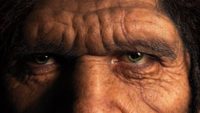The origin of marine reptiles like ichthyosaurs poses a dilemma for evolution. …read more Source: creation.com
By Avery Foley Why are the oldest trees, in an evolutionary timeframe, the most complicated and unlike anything surviving today? …read more Source: AIG Daily
By Heather Brinson Bruce Despite all our advances with human flight, we don’t come close to matching the wonder of birds and their feathered flight. …read more Source: AIG Daily
Limpet teeth break strength record by using the principles of fiberglass-reinforced plastic on a nano-scale. …read more Source: creation.com
Many kinds of eyes exist, but there is no progression of eye designs from simple to complex in the fossils. Even the simplest light-detecting cell requires enormously complicated coordinated biochemistry. …read more Source: creation.com
The genes that affect light and dark skin colour are found across the world, indicating that they were in our population before we spread out across the world at Babel. …read more Source: creation.com
By Dr. David Menton Let’s take a look at the whole matter of aging and death from the perspective of both the Bible and science. …read more Source: AIG Daily
Devonian fossils supposedly hail from a time long before modern oak trees evolved. The Darwinian concept of plants and animals gradually gaining complexity over eons of natural selection paints a picture of simple-to-complex development. But a newly discovered tree fossil from northwest China seems to tell just the opposite tale—that the growth structures in the world’s earliest trees were more complicated than in today’s trees. More… …read more Source: icr.org
By Dr. Andrew Fabich Understanding the flu’s origins will practically aid us in treating the flu virus, so let’s take a look first at what causes the flu. …read more Source: AIG Daily
By Dr. Elizabeth Mitchell The colorful history of the domestic cat, filled in by the latest paleogenetic study, illustrates many fun facts that are consistent with biblical truth. …read more Source: AIG Daily
By Avery Foley According to researchers, the seedy proffering from bird feeders is driving the rapid evolution of bird species. …read more Source: AIG Daily
A genetic copying mistake hampered this bird’s development and limited its lifespan. …read more Source: creation.com
A new discovery forced a rewrite of bird evolution. Chinese fossil discoveries ballooned the number of birds found among dinosaur-containing rocks. But if birds somehow evolved into dinosaurs, then these bird fossils should not be mixed with dinosaur fossils. More… …read more Source: icr.org
There are two major competing ideas for explaining the evolutionary origin of life on earth. In one story life emerges near hydrothermal vents on the ocean floor. The other version of the story is closer to Darwin’s original musings: life arises in a warm pond somewhere on early earth. In a recent study, scientists from Canada are claiming to have given the warm ponds theory a boost.1 Read More: Did Meteorites and Warm Ponds Make Life? | Answers in Genesis
The supposed sequence of plant evolution contradicts the burial order in the fossil record. …read more Source: creation.com
Today’s global population contains people groups with a wide range of skin color. For many years, creation scientists have maintained this variety is due to the inherent created diversity in the original human couple as well as the dispersion of people groups at the Tower of Babel. New research in skin color genetics confirms this biblical narrative. More… …read more Source: icr.org
Thirty-eight fossil lizards reckoned to be 20 million years old-so well-preserved you can see whether their eyes are open or shut. …read more Source: creation.com
A drop of rain brings on an explosive reaction that leads to new life. …read more Source: creation.com
Hell ants may have skewered prey with vampire-like scythes to drain their “bug blood.” Locked in amber around the world are countless tiny flowers and small animals ranging from insects to lizards. Among these are hell ants—extinct ants with scythe-like jaws that moved upward in a vertical plane rather than horizontally. However fearsome these sound, you might well wonder how such an ant could eat. Detailed images of a newly discovered species of hell ant in Burmese amber may hold the answer. All living ants—and lots of fossilized ones—have pincer-like mandibles that converge in front of the face. Their [More]
The wild and woolly world of hybrids is setting evolutionary ideas back on their heels. Species simply don’t arise in the way the evolutionary tree proposes. What do you get . . . when you cross a zebra with a horse? Give up? Why, a zorse, of course! How about crossing a polar bear and a grizzly? If you said “pizzly,” you’re catching on! Do you think I’m joking about these names? Guess again. These are real examples of separate species that can breed and produce unique hybrid babies. Biologists have known about them for a long time, [More]
By Jean O’Micks According to the evolutionary concept of encephalization, endocranial volume increases from more primitive species to more developed ones. …read more Source: AIG Daily
The traditional evolutionary view predicts mutations in eye development genes as being responsible for the removal of eyes in blind cavefish—as if the loss of genetic information is somehow evidence of forward evolutionary progress. Now even this idea has floundered in light of a new study showing that eye loss in cavefish is mediated by a sophisticated adaptive mechanism involving epigenetics. More… …read more Source: icr.org
A short, scrubby tree depends on a tiny bird for survival. …read more Source: creation.com
The human hand is “one of nature’s marvels”, and a huge challenge to robotics engineers wanting to replicate it. …read more Source: creation.com
By Sarah Eshleman Turns out, the three-toed sloth is a complex creature which serves as a testimony to the resourceful and highly imaginative Creator God. …read more Source: AIG Daily
Paleontologists found bits of crustacean shell inside well-preserved dinosaur dung. Besides being a first-time discovery, these dietary supplements challenge the herbivore status of the hadrosaurs that ate them. They also raise questions about why dinosaurs would deviate from their normal diet. More… …read more Source: icr.org
By Dr. Joe Francis What makes orcas so successful at filling the oceans? If you think it’s their size and strength, listen up. …read more Source: AIG Daily






































